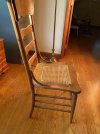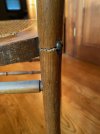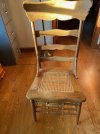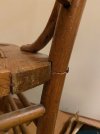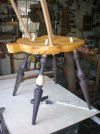It looks to me like the only way to get any strength
and have that screw tie the leg to the seat is to create a spline the width of the leg.
I would remove the screw, then pry the two pieces just far enough apart to syringe some glue in between them, then clamp them up as much as possible and let it set for a few days.
Cut a piece of scrap about 8" long x 1-1/4" wide x 3/4" thick and cut a shallow V-groove right down the center. Gently clamp it to the leg so that the V is directly on top of the screw hole. This should stabilize the leg like a splint while you press on.
From the photos the screw seems to enter the leg from a 45-degree angle relative to the seat. Mark and drill a few small pilot holes exactly 90-degrees away from the screw hole.
Drill one about 2" up from the joint and the other 2" down from it. The holes need to be parallel with one another. If the pilot holes aren't parallel, you can correct that as you increase the bit size. Increase the diameter of the drill bits until you get to about 3/8" which gives you roughly the "Rule of 3" like for a mortise. Draw parallel lines connecting the edges of the holes.
Using a coping saw, cut the waste from between the holes to make a kind of through mortise. Clean up the mortise with a rasp or file. This could be tedious.
Cut a piece of oak to fit the length of the mortise and mill it down to the correct thickness and width. Measure the thickness of the leg at the top and bottom of the mortise to account for the taper, then cut it or sand the spline to shape. Test fit the spline in the mortise and keep adjusting it until you get a decent fit.
Slather it with glue and slide it into the mortise and clamp.
When all is dry, smooth everything out, spot finish, redrill the screw hole, and reassemble.
It might not be pretty, but it should be reasonably strong.
Or I might be completely out to lunch.

